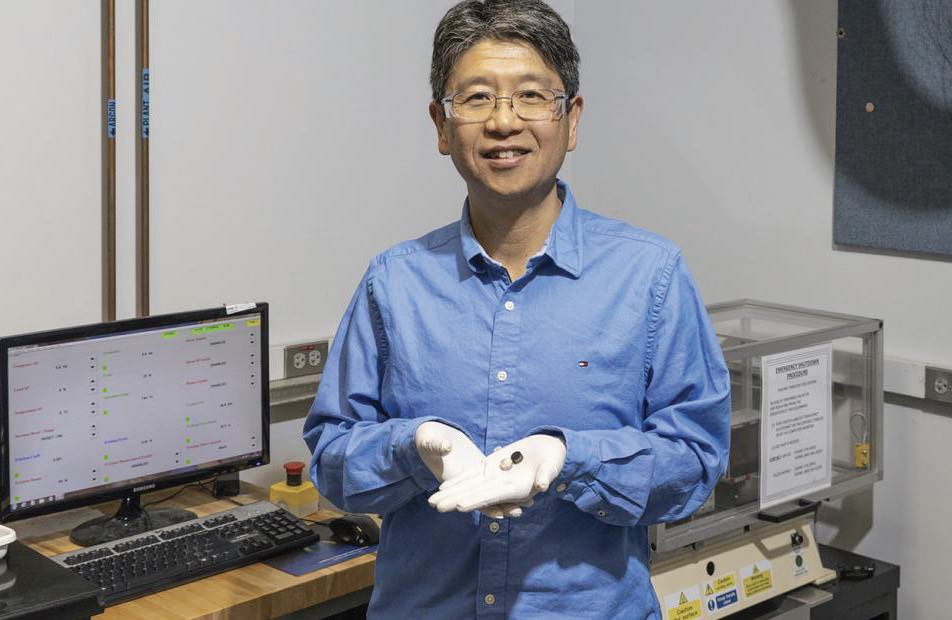Led by innovation
By Dr. Hong Liang, STLE President | TLT President's Report August 2023
We see the impact of earlier innovations in tribology and lubricants today.


STLE Fellow Jun Qu of Oak Ridge National Laboratory shows a recent invention, stainless steel disks before (silver) and after (black) coating with carbon nanotubes that provide superlubricity. Qu and researchers applied for a patent on their novel superlubricity coating. Photo courtesy of Carlos Jones/Oak Ridge National Laboratory, U.S. Dept. of Energy.
As I mentioned in my July TLT President’s Report column, I would like to focus on the leadership of our society overall. This month I will talk about innovation.
STLE is a science and technology society, and we were established because of the advancement of science and technology innovation. As we all know, STLE was established in 1944 and was first known as the American Society of Lubrication Engineers (ASLE). The 1940s was a period of significant advancements in transportation through innovation in aircrafts and automobiles. Many new methods, ideas and products were brought about during this time in our industry, many that we still use today. Notable inventions during this time include the computer, microwave oven, synthetic cortisone and duct tape. Because of market demands, that period became important for the development of lubrication, such as synthetic lubricants and additives.
One of the earlier lubricant products was made of polyalphaolefins (PAOs), which are still widely used today. I recently did a quick patent search related to PAO. There were 53 total patents filed before 1945 and 5,200 since 1946. The ability to polymerize olefins was first reported by F. W. Sullivan Jr. and co-authors R. F. Ruthruff and W. E. Kuentzel in their paper titled “Pyrolysis and Polymerization of Gaseous Paraffins and Olefins,” published in Industrial and Engineering Chemistry journal in September 1935.
1 On a side note, these authors were with the Standard Oil Co. of Indiana, later called Amoco in 1985. In 1911, the oil giant was broken up into 43 various entities and later became seven sister companies. Today, most of those companies are corporate members of STLE.
The point here is that earlier inventors like Sullivan and coworkers pioneered polymerization technology while many other scientists and engineers discovered unique molecules or molecular structures that made vehicles run efficiently. Those are scientific and technical leaders through their research and invention. We see that the impacts of earlier innovation in lubricants have made vehicles operate safely and efficiently and have benefited communities and mankind.
Today there are many inventors within STLE—in friction, wear and lubrication. Because of its multidisciplinary nature, our STLE membership is very diverse. It consists of chemists, chemical engineers, physicists, biologists, mechanical and materials engineers, electrical engineers, data scientists and more. Some spend time on the road visiting customers, many conduct testing and evaluation in field or in laboratories, others manage and organize teams to analyze data and develop strategy and so on. From time to time, we hear about breakthroughs at STLE annual meetings or in published reports. Recently STLE Fellow Jun Qu with Oak Ridge National Laboratory, along with other scientists, invented a coating that could dramatically reduce friction in common load-bearing systems with moving parts, from vehicle drivetrains to wind and hydroelectric turbines.
2 We work with innovators, and we are inventors. Today, we are facing new challenges. Innovation will lead us to move forward and succeed in the future.
REFERENCES
1.
Click here.
2.
Click here.
Dr. Hong Liang is Oscar S. Wyatt Jr. Professor of the J. Mike Walker ’66 Department of Mechanical Engineering at Texas A&M University in College Station, Texas. You can reach her at hliang@tamu.edu.